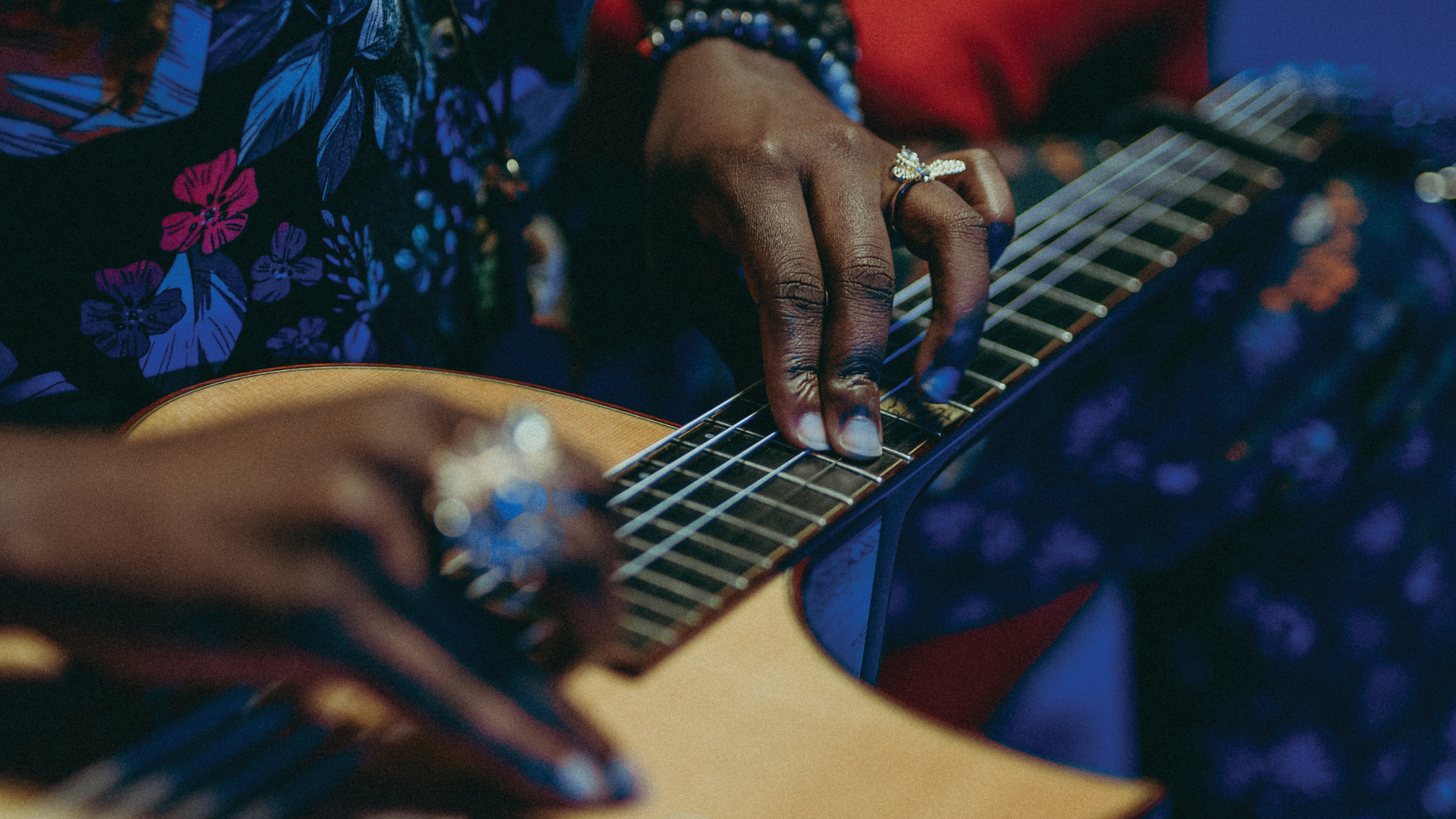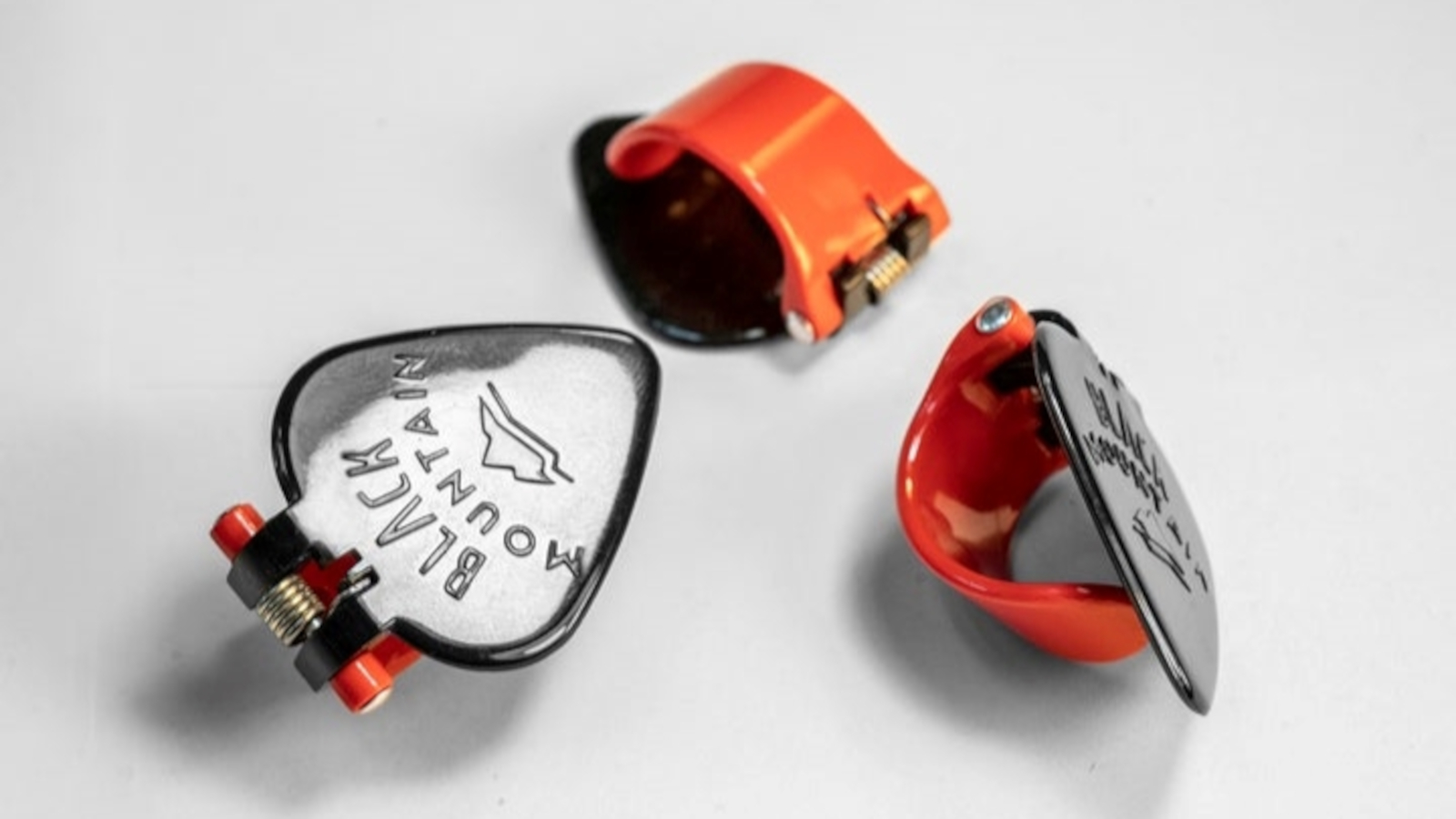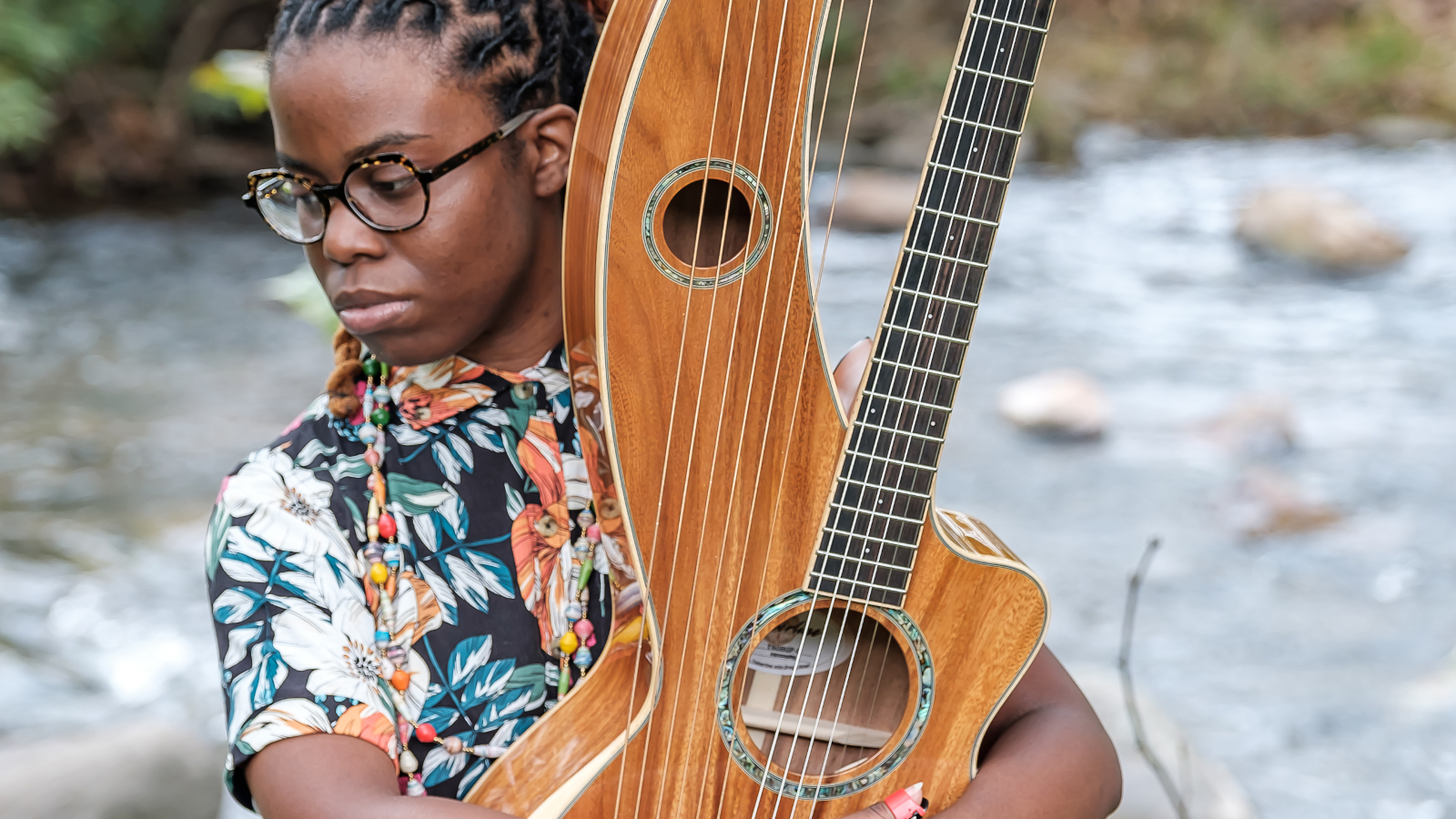Yasmin Williams is a True Guitar Hero for a New Generation of Players
After mastering the ‘Guitar Hero’ game the experimental scholar became a lap-tapping star.

Many guitarists wondered if the Guitar Hero video game craze would spawn a new generation of bona fide guitar heroes. We now have our answer: Yasmin Williams. After mastering Guitar Hero 2 as a youngster, she transferred her finger dexterity into a lap-style tapping technique that is nothing short of extraordinary.
Williams is quite capable of playing traditional upright fingerstyle too, and she alternates between the two positions, sometimes flipping her guitar approach mid-song. Like Kaki King, Williams has a highly inquisitive mind that leads her to try everything from playing with hammers and bows to exploring harp guitar and kora, and experimenting with an arsenal of effects.
Since she sits down and often has the acoustic on her lap like a steel player, her percussive approach is distinctive, and she’ll even use the instrument as a table, setting her kalimba on it and playing it when she’s not plucking guitar strings.
When her hands are fully occupied, Williams makes use of her feet by donning tap shoes and tapping on a board to add more percussion to her mix. In addition, the creative lady has a pedalboard full of gadgets to conjure wild reverbs, delays, loops, synth sounds and backing tracks, but none of this would mean anything if the result wasn’t wonderfully musical.
As impressive as it is to watch Williams, her highly rhythmic and atmospheric audio stands on its own. Both 2018’s Unwind and 2021’s Urban Driftwood (Spinster) are very easy on the ears. Her compositions are interlaced with lovely ebbs and flows, and sound as natural as water cascading along a mountainside. Both albums are excellent acoustic chill mood plays.
Williams is a Virginia native who went on to become the grand prize winner of New York University’s UltraViolet Live talent show, the gold prize winner in the instrumental category of the Mid-Atlantic Song Contest, and a finalist in the Rolling Stone Young Gun guitar competition.
Her long-term future is loaded with possibilities, and her immediate future is chock full of killer gigs with the likes of Andy McKee, Mike Dawes and Tommy Emmanuel. Make sure to catch the youngster with the fresh perspective that will make you wonder, Why didn’t I think of that?
All the latest guitar news, interviews, lessons, reviews, deals and more, direct to your inbox!
Just as Edward Van Halen popularized traditional two-hand tapping while not exclusively inventing it, Williams has the potential to do so with lap tapping. Dawes does some lap tapping, and both he and Williams acknowledge the advanced pioneering style of Canada’s Erik Mongrain, whose “AirTap!” video has garnered more than seven and half million views on YouTube since its posting in 2006.
According to Williams, he has long since retired the technique, and she was unaware that anyone else had ever played that way when she started. It was simply her curiosity kicking in back when the 24-year-old was a teenager. In any case, the torch is clearly in her capable hands.

How did you make the leap from guitar gamer to guitar player?
I started playing Guitar Hero 2 when I was 11, and after I beat the game at the highest level, my parents got me an electric guitar. At first it was a lot of Hendrix and Nirvana. I thought Nirvana would be easy to figure out, and I was trying to find stuff that was on my beginner level and still something I wanted to play.
I eventually got sick of playing the same chords over and over. It just wasn’t my style. So after a few years, I switched to acoustic guitar. I remembered that on the expert level of the game, the difficult songs have a lot of tapping, so you have to kind of tap out the notes on the controller. It’s not similar to playing an actual guitar at all, but I wanted to transfer my tapping technique from a Guitar Hero controller over to a real guitar. I eventually figured it out, and that was the start of playing the way I do now.
Can you detail your left-hand technique for lap tapping?
To me, it’s kind of obvious, but a lot of people do ask me questions like, “How can you play guitar with one hand? Don’t you need to strum with your right hand?” No. I’m simply hammering on and pulling off. You don’t even have to press particularly hard with your left hand. You literally tap down on the fret and then pull off the string. I just figured out how to do it quickly and then incorporate a lot of other things simultaneously. I find it easier to tap with the guitar on my lap. I can do it faster and more accurately, and it facilitates a lot more stuff, such as percussive playing. It’s easier for me to do it that way than the way Andy McKee does it, for example. It’s basically the same thing, just a different orientation.
You literally tap down on the fret and then pull off the string. I just figured out how to do it quickly and then incorporate a lot of other things simultaneously
Yasmin Williams
Your fingerpicking technique is interesting too, because you play with what appears to be a cross between a thumbpick and a flat pick. Can you explain it?
I play with a Black Mountain thumb pick, which has a spring that allows it to fit all thumb sizes. You can use it like a flatpick or a thumbpick, and I find it more comfortable than a typical pick, and the average thumb pick, too. Some of my newer songs have a lot of strumming, and I can’t strum comfortably at all with a regular thumb pick.

Your recent NPR Tiny Desk Concert video is wonderfully revealing. “Juvenescence” starts with traditional fingerpicking, and then you flip the guitar over mid-song into lap tap mode. How did that develop?
I do that in a few of my songs and it’s mainly a compositional thing. If I imagine a bridge or a B section with tapping parts I hear in my head that I can’t play upright, I figure out a way to switch during the song, and I try to make the transition as seamless as possible. “Juvenescence” works well because there’s a natural pause with the harmonic ringing out. On other songs I’ve got give myself a maybe a millisecond for the switch to make sense. On some songs, like “I Wonder,” I switch for a section that I have to play on my lap, and then I switch back.
Do you primarily work in open D Vestapol, like open E down a step, so that from low to high the strings are D A D F# A D?
Yes. I didn’t get there by learning old blues tunes or anything like that. I was young, maybe 14 years old, when I first tuned my guitar to something that sounded good to me. I eventually looked it up and then realized that playing in open tunings was a thing. I tried out a bunch of them, and open D was still the one that spoke to me and allowed me to write the best songs.
I use a capo to make the song easier to play, with less stretching, and to find the key where the song sounds best
Yasmin WIlliams
I have some songs in open G, and I’ve made up a few of my own tunings, including an open C suspended that I use for “Swift Breeze.” From low to high, it goes C G D G B D. On my Timberline harp guitar I use a weird G tuning with an F# on the lowest string, but I generally use open D with a capo somewhere in the first four frets.
Most people use capos to put a song in the best key for vocals, but that didn’t occur to me. I use a capo to make the song easier to play, with less stretching, and to find the key where the song sounds best. “Juvenescence” sounds best in the key of F, so I place a Shubb Capo Royale at the third fret.

Can you detail your unique workhorse?
I play a Skytop Grand Concert, which has two big sound holes on the top side that provide a stereo effect with the sound going to my right and left ears. It’s like my head is covered in sound. Skytop guitar tops don’t normally have sound holes.
My guitar is kind of weird because it has little holes in the top, and those occur naturally in this wood, which is like a piece of driftwood. It was underwater for a long time in the Pacific Northwest, where Teredo mollusks burrowed into the wood, and that’s why it’s called Teredo Sitka spruce.
It’s so cool that the guitar has these huge natural influences, because I love nature, and that’s basically what 'Urban Driftwood' is all about
Yasmin Williams
Since I play with the guitar on my lap a lot, the sound from the main sound holes gets muffled pointed toward my belly, I asked if there was any way to get the sound to travel out from the top a bit more, and the solution was Teredo Sitka, with those little natural holes that help it do that.
The back and sides are made of spalted tamarind. It looks really cool, and I came to find out that spalted wood looks the way it does because of a fungus. It’s so cool that the guitar has these huge natural influences, because I love nature, and that’s basically what Urban Driftwood is all about.

In addition to solo acoustic effects staples such as the Pigtronix Infinity Looper, Strymon BigSky reverb and a ToneDexter preamp, we noticed a couple of uncommon pedals on your board. Can you share insights on the Hologram Microcosm and the Looptimus?
I love reverb so much that if I could have an entire board full of just reverb pedals, I would. I mainly use a room reverb on the BigSky that sounds good everywhere, and I also use a cathedral setting that I like to use at the end of a song.
The main thing on the Microcosm is a granular delay. There are four stereo reverbs on top of that, and then there is a micro-looper on top of that. You can create some wild stuff when all of those things come together. The Microcosm is rather new to me, and I’ve barely scratched the surface of that pedal.
I love reverb so much that if I could have an entire board full of just reverb pedals, I would
Yasmin Williams
I love the Pigtronix Infinity Looper because it has two inputs. So for example when I play “Jurabi” from Urban Driftwood, I can plug my kora into one input, my guitar into the other, get a loop going and play the song.
I mainly use the Looptimus to trigger backing tracks, and I also use it to trigger synth patches from an iPad. I use my feet to trigger one of six chords, which is great because my hands are taken.
It’s easy to imagine legions of players being influenced by your unique style and trying to imitate you. Have you seen much evidence of that?
Since the NPR Tiny Desk Concert video came out, people have been sending me videos of their small children trying to imitate me on their little guitars and ukuleles. I love that, it’s so cute. I’m excited about the future for sure, and I would love to inspire a new generation of players.
Buy Yasmin Williams's latest album Urban Driftwood here.
Jimmy Leslie is the former editor of Gig magazine and has more than 20 years of experience writing stories and coordinating GP Presents events for Guitar Player including the past decade acting as Frets acoustic editor. He’s worked with myriad guitar greats spanning generations and styles including Carlos Santana, Jack White, Samantha Fish, Leo Kottke, Tommy Emmanuel, Kaki King and Julian Lage. Jimmy has a side hustle serving as soundtrack sensei at the cruising lifestyle publication Latitudes and Attitudes. See Leslie’s many Guitar Player- and Frets-related videos on his YouTube channel, dig his Allman Brothers tribute at allmondbrothers.com, and check out his acoustic/electric modern classic rock artistry at at spirithustler.com. Visit the hub of his many adventures at jimmyleslie.com
